
16 minute read
Increasing Disaster Resilience for Nepal s School Sector
Nepal is located in a high hazard zone with high vulnerabilities and exposure, leading to potentially high risk and grave consequences from natural disasters, especially from earthquakes. The country lies on several active faults where possible epicenters are located at rather shallow depths, increasing the probability of Nepal experiencing very strong ground motions.
Due to the growing understanding of the importance of disaster resilience (DR) in Nepal, many programs have been initiated in many sectors, including the establishment of National Risk Reduction Consortium (NRRC), comprising of five flagship programs.
Advertisement
School and Hospital Safety. Led by the Asian Development Bank (ADB), World Health Organization (WHO), and Nepal’s Ministry of Education (MOE) and Ministry of Health (MOH), it aims to build the earthquake resilience of schools and hospitals through retrofitting, training, raising awareness, and safety measures.
Emergency Preparedness and Response. Led by UNOCHA and Nepal’s Ministry of Home Affairs (MOHA), it seeks to enhance the government’s preparedness and response capabilities at the national, regional, and local level.
Flood Risk Management in Koshi River Basin. Led by the World Bank (WB) and Nepal’s Ministry of Irrigation, this initiative aims to protect the country from flood-related disasters.
Community-based Disaster Risk Management. Led by the International Federation of Red Cross/Red Crescent Societies and Nepal’s Ministry of Local Development, this effort aims to prepare 1000 VDCs to become disaster resilient.
Policy/Institutional Strengthening. The United Nations Development Program and Nepal’s Ministry of Home Affairs lead with the aim of enhancing government’s disaster risk management capacity centrally and at the municipal and local level.
Author:
Naveed Anwar, Ph.D.
Executive Director, AIT Consulting Director, Asian Center for Engineering Computations and Software (ACECOMS), Affiliate Faculty, Structural Engineering, Asian Institute of Technology

One such program is the School Safety Program (SSP) which was initiated and is being funded by the Asian Development Bank (ADB) and the Australian Agency for International Development under the Flagship 1 of the NRRC. As a Technical Assistance Program, SSP is being implemented through Nepal’s Department of Education (DOE), under the Ministry of Education (MOE) which is the government agency responsible also for the school sector. This program initially targeted about 260 public school buildings in Kathmandu Valley (KV) for retrofitting to increase resilience to earthquakes. SSP also included capacity building programs for masons, teachers, students, and professionals in the DOE within a 2-year duration starting from 2012. Many of these activities have been successfully completed to date. 100% Even though SSP covers less than 0.3% of total scope of schools in the country, and is only administered in KV, it has helped to identify several challenges, such as the lack of capacity and resources, need for better technological solutions, quality assurance, financial management, reconsideration of the role of community, and coordination amongst various stakeholders. Tackling the disaster risk reduction (DRR) activities in the entire country with a scale that is 300 times larger, spread over 75 districts, needs a clear strategy and plan. Streamlining existing processes and developing innovative ways to increase and sustain DR is the key to accomplishing scaling up.
90%
100% 80% 90% 70% 80% 60% 70% 50% 60% 50% 40% 40% 30% 30% 20%
20% 10% 10% 0%
Ecological Belt Plains/Teral Hills Mountains East 0% Ecological Belt Plains/Teral Hills Mountains Central East West Mid-West Far-West Kathmandu Valley Other Districts (72) Urban Rural Kathmandu Valley Central West Mid-West Far-West Kathmandu Valley Other Districts (72) Urban Rural Kathmandu Valley Administrative Region Administrative Region Note: The darker shade refers to private District Urban/Rural Development District Urban/Rural Development schools, the lighter shade refers to public schools.
Note: The darker shade refers to private schools, the lighter shade refers to public schools. Note: The darker shade refers to private schools, the lighter shade refers to public schools.
School Distribution-based on Four Categorizations: Ecological Belt, Administrative Region, District, and Urban/ Rural Development
The School Sector Reform Plan 2009-2015 (SSRP) is another key project of MOE which serves as the basis for most of the improvements and modifications in the school sector. Reports showed minimal issues in implementation and that most of the district-level programs were observed to be satisfactory. The SSRP is considered a potential platform for integration with SSP and for scaling up the DR initiatives. The specific challenges identified is summarized as the need to address the shortage of resources, increased capacity building in various actors, appropriate budget allocation and financial approval systems, cost-effective retrofitting solutions, and improved focus on quality assurance, coordination, and management. These challenges can be summarized as:
Scale and Complexity
Political
Governance
Legal
Financial
Technical
Management
Social
The scale and complexity in terms of the number of schools, their geographical and regional distribution, and the number of the stakeholders involved.
Need for reinforcement of will at the top levels, the commitment to this will, assigning a high priority, making of appropriate policies and legislations, and continuity until the objectives are achieved.
Strengthening the appropriate frameworks and organizational structures to handle this task.
Need of sufficient and appropriate legal frameworks based on the policies and regulations, and corresponding enforcements.
Need of financial resources for undertaking the scaled up tasks, the integration of the DRR activities in appropriate budgets, the possible misuse of funds, and delays in realization of the allocated funds.
Need for greater ability and capacity to handle planning and design aspects, lack of intervention technologies, QE/QA/QC issues, and lack of relevant research.
Lack of capacity, frameworks, and mechanisms for all aspects related to management, coordination, reporting, monitoring, and evaluation.
Not enough public awareness on the significance of DRR, lack of acceptance of the intervention solutions, low/inadequate community contributions.
Increasing DR in Schools: Overall Strategies and Actions
Recognizing and supporting the several ongoing and planned initiatives and programs related to DRR in Nepal, and to ensure an increased effectiveness and reduced instances of duplicated efforts and emphasize focus on DR of schools, the strategies are divided into two categories; Linked and Stand-alone.
Linked strategies refer to those that have relationships, ownership, and/or relevance to the National DRR initiatives, but will also impact the DR of the school sector. These strategies are either based on strengthening and supporting other ongoing and planned initiatives or needs integration with them. Six strategies are proposed under this category:
1. Increased DR awareness in various stakeholders, at various levels.
2. Continuous reinforcement of will and commitment to DR at the highest levels of the government and development partners. 3. Increased institutionalization and coordination to tackle the risks and consequences of various disasters. 4. Building overall capability and capacity of different stakeholders for DRR.
5. Facilitate and support local research to aid in providing relevant solutions for measures leading to DRR. 6. Development and/or amendment of policies, acts, and regulations, and their enforcement for enabling implementation of various strategies, actions and measures aimed at DRR of various sectors, including the schools.
Stand-alone strategies are specific strategies that are primarily applicable to the school sector and can be implemented mostly independently within the defined frameworks. These consist of the following nine strategies:
1. Building competency-based capability and capacity of the agencies directly involved in the implementation of the DRR process.
2. Classification, categorization, and standardization of the intervention solutions for the vast scale of schools and buildings capitalizing on the geographical, administrative, rural/urban, building materials, and size variations.
3. Prioritized increase in multi-hazard DR for public schools, based on the disaster consequences as the primary parameter derived from hazard levels, vulnerability, and exposure, using a combination of one-time and incremental safety approaches.
4. Increased DR of private schools through a combination of appropriate regulations, licensing, certification, technical and administrative support, and incentives, in close collaboration with private sector.
5. Integration of DR into SSRP and other related development plans for maximizing the cost and resource effectiveness, and to avoid duplication and conflicting interventions.
6. Certification of the DRR process and the final outcome, through continuous quality assurance mechanisms and formal inspections, combined with voluntary DR rating.
7. Increased community DR through systematic and assured involvement of the community in awareness, capacity building, intervention implementation, monitoring the final outcome of increased school DR.
8. Integration of various aspects of DR into the academic and professional curricula, progressively from basic awareness to vocational training and advanced knowledge and skill sets.
9. Implementation of results-based monitoring and evaluation performance management plans to ensure the achievement of the outputs and outcomes.
The scale and complexity of the tasks require the engagement of many stakeholders carefully aligned with appropriate linkages for a strong and flexible framework that is necessary for the implementation of the DR strategies at a national level.
Choosing between Rebuild and Retrofit:
When deciding whether to retrofit or rebuild, the following strategy and considerations are important:
All historical, monumental, or national heritage buildings must be considered as special cases by the Technical Advisory Committee (TAC).
A purely on cost basis following criteria is recommended in order to consider the overall benefits of the investment. In essence, older vulnerable buildings should be considered for re-build, as it will not only improve DR but also the functionality, and possibly land and/or space utilization. Newer vulnerable buildings should be preferred for retrofit, even at a higher relative cost.
While computing rebuilding cost, the savings due to possible re-use of material from existing buildings should be considered.
General considerations based on the age and vulnerability of selected buildings are outlined below:
10 year old buildings that are very vulnerable
10-20 year old buildings with high vulnerability
20-40 year old buildings
40+ year old buildings
Up to 70% of the new building cost may be allowed for retrofitting; if more than 70% is required, then consider new construction 50-70% of the new building cost may be allowed for retrofitting, if more than 70% is required, then consider new construction 20-50% of the new building cost may be allowed for retrofitting, if more than 50% is required, then consider new construction New construction is preferred unless the retrofit cost is less than 20%
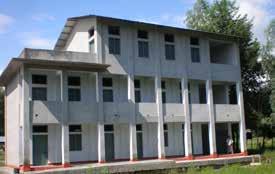
Working Together: Ownership, Implementation, and Coordination
The scale and complexity of the tasks require the engagement of many stakeholders carefully aligned with appropriate linkages for a strong and flexible framework that is necessary for the implementation of the DR strategies at a national level. To address this, a thorough review was performed. A coordination framework largely reinforced by a collective agreement for the MOE through the DOE, to take ownership of the entire program as the primary implementing and coordinating agency, actively supported by the Department of Urban Development (DUDBC) under the Ministry of Urban Development (MOUD). Frequent and smooth coordination with other ministries and the Office of the Prime Minister will help ensure that the objectives of this program are met.
Due to the level of community participation that is prevalent in Nepal, it is also proposed to reconsider the roles for community participation in the school DRR process. The roles can promote ownership by the community’s inclusion in basic training programs and thereby equipping the community with skills in order to respond to various hazards and disasters. The community may also be involved in fundraising and generating other in-kind resources and services related to the process, direct intervention (construction) activities, and monitoring the works carried out by other parties, together with the district education office (DEO), village development committees (VDCs), and consultants.
A separate, dedicated coordination office is proposed for the coordination of the entire school DRR process. This office will function as a clearing house and repository of all information generated and needed to smoothly carry out various aspects of the overall process, and will coordinate with various government agencies, development partners, UN agencies, INGOS/ NGOS, private school operators, technical committees, the media, and other stakeholders.
What is Needed: The Plan
Prioritization
Considering the large scale of the intervention, it is important to prioritize the tasks and schools identified for intervention, so that the finances and resources can be allocated efficiently and utilized effectively. Three levels of prioritization are considered: a. High priority tasks, without which the DRR process cannot be initiated. This includes generation of detailed school and building inventory for all schools in the country, formulation of policies, conducting/obtaining risk assessment studies, development of design criteria and guidelines, classifications and categorizations, and development of standardized solutions.
b. A macro-level (district) priority grouping for the implementation of the DRR process which is primarily based on the anticipated disaster consequences.
This is done by assuming that the vulnerability of the buildings is of similar order in all districts, and therefore considering the hazard levels, student density per classroom, population density of the district, and the overall conditions of the buildings as the main parameters. This prioritization is done with a view to gain maximum benefit from the intervention.
c. A local-level prioritization of the individual schools and buildings, within the districts, based on detailed assessments, and considering other relevant factors.
This is to be done at the implementation stage, and is not considered in the current plan.
Four district-level priority groups have been initially planned based on the available data. This grouping should be re-evaluated once the basic school inventory is completed for the entire country. The categorized groups, number of districts in each group, number of students in public schools that will benefit from the intervention are presented below, together with associated cost:
Group-1 Group-2 Group-3 Group-4 3 Districts of KV 23 Districts 21 Districts 28 Districts
151,385 Students 3,055,830 Students 1,701,777 Students 1,284,020 Students

Priority Groups Distribution, by District
Group
It is very important to note, that for KV, more than 70% of the students are in the private schools (about 3 times more of those enrolled in public schools). The focus of priority Group-1 must on private schools, in addition to the ongoing and future plans for public schools.
Ministry of Education
Public and
quired are Technical Advisory Committee, Development Partners, UN Agencies, INGOs, and NGOs.
Community Supported Primary to High Schools
Vocational
A significantly large number of staff was estimated to be may not be available to undertake the implementation tasks.
Colleges
Universities Colleges
Private Self-owned or Rented
Institutional
Direct Intervention by DOE
Direct Policy Guidelines Certification by MOE
Policy and Regulation License Renewal By MOE
Ministry of Urban Development
DUDBC
Coordination
Coordination Technical Support
Regulations Inspections Certification
Resources
The primary resources needed for implementation are from DOE, DUDBC, DEOs, consultants, contractors, and coordination office; whereas the supporting resources re
The average number of estimated resources required during the execution and implementation of the prioritized plan, over a period about 8 to 10 years have been calculated to the proponents of the program.
increased in DOE, DEO, and DUDBC to support the largescale implementation. The involvement of international firms will be essential to supplement and support the local capacity in cases when consultants and construction firms
Conceptual Framework for Sharing DR Responsibility
2011

Students per Classroom
3
3-20 3-30 3-45 45-80
Classrooms
2021 (Projected)

Population Density
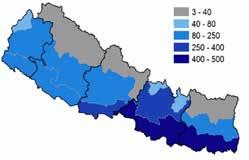
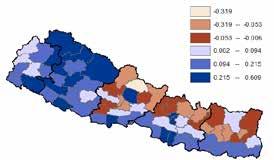
Finances
The cost to implement this program is estimated to be equivalent to about 8,000 NPR (roughly 80 USD), per student enrolled in the school system. This means the safety of nearly all children (enrolled in schools) from natural disasters can be significantly improved/ensured by spending about 10 USD, per child, per year for the next 8 years on school DRR. This is equivalent to less than 1 USD per month per child. This includes the finances needed by DOE and DUDBC to implement the strategy proposed for the private schools. A total 55,725 Million NPR (approximately 560 Million USD) may be needed for completing the DRR of all public schools in the country, in about 8 to 10 years duration.
Additional cost may be incurred by the various ministries, development partners, UN agencies, NGOs, various professional organizations, academic institutes, and committees that support the overall DRR process were not explicitly included in this estimates. It is likely that these incidentals will be covered as part of the commitment of these organizations to the cause.
Increased School Sector Resilience to Disasters, A Priority and Necessity
School buildings and the surrounding premises are prone to particularly high risks due to the large number of students studying in relatively small, inappropriately designed and constructed buildings. Due to Nepal’s susceptibility to natural disasters, the loss of human, economic, and education facilities after a strong event will be of an enormous scale. By increasing the DR of schools and its infrastructure, these consequences can be averted or reduced significantly. These buildings can also provide the much needed immediate shelters and temporary relief centers for the surrounding communities, which are equally or even more vulnerable.
The scale and complexity of the tasks require the engagement of many stakeholders carefully aligned with appropriate linkages for a strong and flexible framework necessary to implement DR strategies at a national level.
On New Schools
In planning for the constructing new schools, an average of 35 students per classroom was projected for each district for all schools (public and private). Results show that by 2021, approximately 45,000 new classrooms must be constructed to satisfy the projected demand in Nepal. Given that an estimated 20% of the new classrooms will be private, a total of 36,000 new public classrooms will need to be constructed by 2021 in Nepal.
For the hilly and mountainous areas that are sparsely populated, innovative solutions such as adopting an Education Village concept may prove to increase occupancy rate in the classrooms by reducing the student’s travel from daily to weekly, increase mobilization effectiveness, and maximize the utilization of resources. An Education Village will essentially transform underutilized school infrastructures, with the possibility to merge with other schools, to provide both academic and lodging facilities to students.
The plan and strategy outlined for the school sector of Nepal were partial results of the project, Capacity Development for School Sector Program Implementation (TA 7935 NEP) Contract Number: 106698-S79855, awarded by the Asian Development Bank to the author.
The views expressed in this publication are those of the authors and do not necessarily reflect the views and policies of the Asian Development Bank (ADB) or its Board of Governors or the governments they represent. ADB does not guarantee the accuracy of the data included in this publication and accepts no responsibility for any consequence of their use.
By making any designation of or reference to a particular territory or geographic area, or by using the term “country” in this document, ADB does not intend to make any judgments as to the legal or other status of any territory or area.
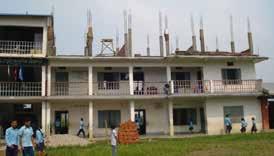
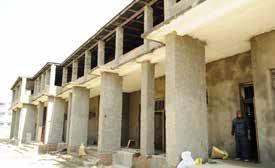
Applications of Remote Sensing in Post-Disaster Management
By

Manzul Kumar Hazarika
In recent years, more and more remote sensing satellites are becoming available and this has made it possible to acquire satellite images of a disaster-affected area immediately after a disaster event. An initiative called Sentinel Asia was launched in 2005 by a few space agencies of Asia serving 25 countries in Asia.




